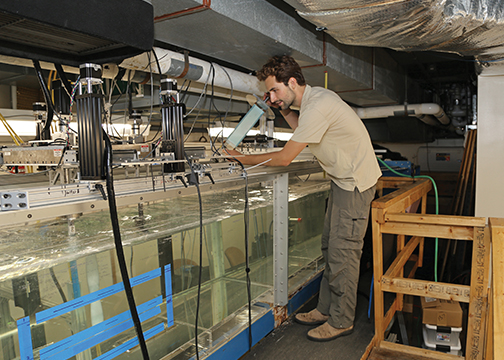Combining a mixture of mechanical engineering design with novel parametric optimization strategies and signal processing, Ilan Upfal spent hours of his spring semester working with compliant hydrofoils in the Breuer lab’s water flume. Specifically, he used a membrane wing inspired by a bat’s wing, operating in the dynamic stall regime, to harvest energy from tidal or river flows.
Upfal expanded upon the research begun in the Breuer Lab by former members Varghese Mathai and Gali Alon Tzezana, who studied the fluid structure interactions of the flapping of these membrane wings, from a joint experimental/theoretical perspective. Early results operating in an energy harvesting regime were very exciting, compared to the rigid wings.
“Membrane aerodynamics is still a huge open theoretical area, which I have not engaged in much at all, so I pretty much just did the experimental work,” Upfal explained. “I designed my own wing to replace what was previously being used in order to expand the parameter space that could be searched, and also implemented a live optimization routine that can be used to iterate through different kinematics - basically an intelligent search through the parameter space to control the experiment in real-time, using a simplex algorithm.”
Upfal’s project was awarded a Doris M. and Norman T. Halpin prize, seed money to support the innovative and interdisciplinary project, and also served as his senior thesis.

“The idea is to put this generator in an opening to a bay with a strong tidal flow, or river,” he said. “A feasibility study showed that it may be cheaper to implement this kind of a generator in isolated, rural communities, instead of shipping in diesel to use a traditional generator. The big advantage is that the tip speed of this generator is much lower than if you had a rotary turbine, like a windmill. The wing is flapping in an up-down motion, similar to the speed of a fish.”
An electrical engineer whose passions lie with sustainable energy in almost all its forms, Upfal was introduced to Professor Breuer’s lab through a fluid mechanics class taught by Professors Tom Powers and Roberto Zenit. “I was excited to get my feet wet in research. I had looked at a lot of amazing labs at Brown, and had just taken fluid mechanics which I really enjoyed,” he said. “I was fascinated by Professor Breuer’s research areas and his work with bio-inspired design. I felt like there were parallels between fluid mechanics and electrical - the math overlaps in a cool way - so I just talked to him and felt like he was excited about giving me the opportunity to pursue what I was curious about.”
The excitement with which Upfal describes his lab experiences, his courses, and his overall time at Brown is palpable. “I am really excited to be where I could both pursue a scientific education, while also being at a place that is really strong in humanities and social science. Throughout my time here at Brown I have really thrived, being able to have myself intellectually challenged on social-political-historical topics and also be challenged in a rigorous STEM program.”
With a semester still to go to complete his degree, Upfal has some decisions to make about his future. If the past is any indication, those decisions will be guided by thoughtful discourse and passionate execution. He started as an environmental studies concentrator at Brown and it was actually a history course, From the Columbian Exchange to Climate Change: Modern Global Environmental History, with environmental historian Bathsheba Demuth that he credits with turning him toward an engineering degree. “She really forced me to think deeply about how humans engage with their environment and the ways that they can choose to do that, which I found inspiring because it made me believe that as an engineer, or engaging in policy or technology, it is not inevitable that we destroy our planet; we do have a choice. It was really fascinating to take her class and learn about different kinds of societies and cultures, and how they engage with their environments.
“I’m really passionate about renewable energy and transitioning our economy into one that is sustainable. I’m interested in the electrical grid, and storage and metascale management of uncertainties and loads and intermittent generation and I’m hoping to get into an exciting company working in that space, or be able to do that kind of research in graduate school.
“In my first year at Brown, I didn’t take a single engineering class. It took me a second to get around to this, and it was in large part because of Professor Demuth. She really inspired me. I’ve always loved STEM, but I felt demoralized, and wasn’t sure that we could build things better. She inspired me to come back around and say, ‘I like STEM and I'm going to do this, and we’re going to do things differently.’